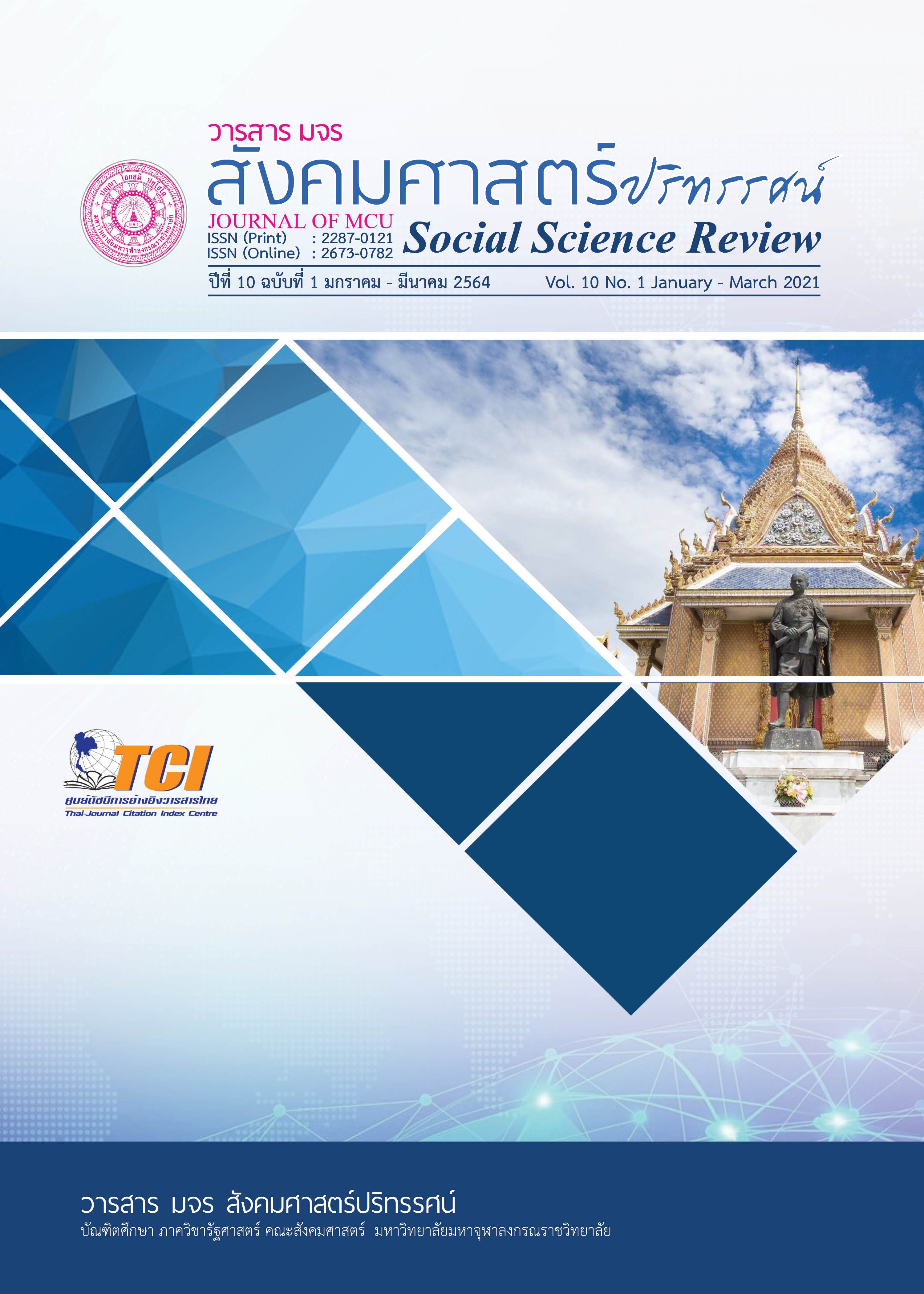การพัฒนาศักยภาพและโอกาสของคนรุ่นใหม่ในการออกแบบอนาคต ชุมชนเชิงสร้างสรรค์
คำสำคัญ:
การพัฒนาศักยภาพและโอกาส, คนรุ่นใหม่, อนาคตชุมชนเชิงสร้างสรรค์บทคัดย่อ
บทความวิจัยนี้มีวัตถุประสงค์เพื่อถอดองค์ความรู้ กระบวนการ ออกแบบกิจกรรมและนำเสนอโมเดลการพัฒนาศักยภาพและโอกาสของคนรุ่นใหม่ในการออกแบบอนาคตชุมชนเชิงสร้างสรรค์ เป็นการวิจัยแบบผสมผสานของการวิจัย 4 ประเภท คือ การวิจัยเชิงเอกสาร (Documentary Research) การวิจัยเชิงปริมาณ (Quantitative Research) การวิจัยเชิงคุณภาพ (Qualitative Research) และการวิจัยเชิงปฏิบัติการแบบมีส่วนร่วม (Participatory Action Research) ผลการวิจัยพบว่า 1) การพัฒนาศักยภาพคนรุ่นใหม่มี 4 ด้าน คือ ด้านความรู้ ด้านทักษะความสามารถ ด้านมนุษยสัมพันธ์ และด้านการทำงานเป็นทีม พัฒนาด้วย 4 กระบวนการคือ การพัฒนาความคิดและการจัดการ การพัฒนาความสัมพันธ์และการดูแล การพัฒนาการทำงานและการเป็นผู้ให้ การพัฒนาการดำเนินชีวิตและการพัฒนาตนเอง 2) กิจกรรมในการพัฒนาศักยภาพและโอกาสของคนรุ่นใหม่ ได้แก่ หลักสูตร “การฝึกอบรมศักยภาพเยาวชนในการออกแบบอนาคตชุมชนสร้างสรรค์” มีเป้าหมายเพื่อใช้เป็นงานฝึกอบรมและพัฒนาเสริมสร้างทักษะเด่นที่มีอยู่ในเยาวชนให้มีความโดดเด่นและนำไปสู่การสร้างสิ่งสร้างสร้างสรรค์ 3) โมเดลการพัฒนาศักยภาพและโอกาสของคนรุ่นใหม่ในการออกแบบอนาคตชุมชนเชิงสร้างสรรค์ ประกอบด้วย ขั้นที่ 1 พัฒนาความคิดในตัวเอง ขั้นที่ 2 พัฒนากระบวนการคิด ตระหนักในความคิด พัฒนาความคิดสร้างสรรค์ สู่การทดลองปฏิบัติ ขั้นที่ 3 เสียสละ บำเพ็ญประโยชน์ แสดงออกต่อชุมชน ส่วนรวม ภายใต้กรอบ สร้างสรรค์ เป็นประโยชน์ สอดคล้องกับช่วงวัยและความรู้ความสามารถ
เอกสารอ้างอิง
เกศินี ปทุมสุวรรณ. (2559). เมืองสื่อสร้างสรรค์: ตัวชี้วัดเพื่อการพัฒนาเยาวชน. วารสารวิชาการ มหาวิทยาลัยหอการค้าไทย มนุษย์ศาสตรและสังคมศาสตร์, 36(2), 55-69.
ขัตติพงษ์ ด้วงสำราญ. (2562). การออกแบบพื้นที่สร้างสรรค์ : กรณีศึกษามหาวิยาลัยเทคโนโลยีราชมงคลตะวันออกวิทยาเขตอุเทนถวาย. วารสาร มจร พุทธปัญญาปริทรรศน์, 4(2), 253-266.
ชุติมา จันทรมณีและคณะ. (2555). การเสริมสร้างศักยภาพเด็กและเยาวชนโดยการมีส่วนร่วมของชุมชนในพื้นที่กึ่งเมืองกึ่งชนบท : กรณีศึกษาบ้านด้ามพร้า ตำบลขามใหญ่ อำเภอเมืองจังหวัดอุบลราชธานี. วารสารศิลปศาสตร์ มหาวิทยาลัยอุบลราชธานี, 8(1), 218-236.
นันทนิษฎ์ สมคิด. (2562). แนวทางการพัฒนาชุมชนสร้างสรรค์ในเขตพื้นที่จังหวัดจันทบุรี. วารสารมหาจุฬาวิชาการ, 6(ฉบับพิเศษ), 319-333.
นิโลบล วิมลสิทธิชัย. (2561). ห้องสมุดโรงเรียนกับพื้นที่สร้างสรรค์: แหล่งเรียนรู้เพื่อพัฒนาทักษะผู้เรียนในศตวรรษที่ 21. วารสารห้องสมุด, 63(1), 1-29.
บุษกร วัฒนบุตร. (2555). การนำพุทธญาณวิทยา (ไตรสิกขา) และตัวแบบ KSM เพื่อสร้างและพัฒนาทุนมนุษย์ในองค์กรมหาชน (วิทยานิพนธ์ปริญญารัฐประศาสนศาสตรดุษฎีบัณฑิต สาขาวิชารัฐประศาสนศาสตร์). ปทุมธานี: มหาวิทยาลัยราชภัฏวไลยอลงกรณ์ ในพระบรมราชูปถัมภ์.
พรชัย ด้วงทองสุข และคณะ. (2560). โปรแกรมพัฒนาความคิดสร้างสรรค์โดยการกระตุ้นระบบประสาทแบบองค์รวม สำหรับผู้บริหารโรงเรียน. วารสารวิทยาการวิจัยและวิทยาการปัญญา, 15(1), 1-19.
วันชัย สุขตาม. (2555). การพัฒนาทุนมนุษย์วิถีพุทธในยุคโลกาภิวัตน์ (วิทยานิพนธ์ปริญญารัฐประศาสนศาสตรดุษฎีบัณฑิต สาขาวิชารัฐประศาสนศาตร์). ปทุมธานี: มหาวิทยาลัยราชภัฏวไลยอลงกรณ์ ในพระบรมราชูปถัมภ์.
ศรีวรรณ ฉัตรสุริยวงศ์ และมาเรียม นิลพันธุ์. (2559). กระบวนทัศน์การจัดการเรียนรู้โดยใช้ชุมชนเป็นฐานเพื่อส่งเสริมความสามารถด้านการคิดอย่างมีวิจารณญาณและการแก้ปัญหาเชิงสร้างสรรค์สำหรับนักเรียนระดับประถมศึกษา. วารสารศิลปากรศึกษาศาสตร์วิจัย มหาวิทยาลัยศิลปากร. 8(1), 183-197.
ศุภชัย เหมือนโพธิ์และคณะ. (2561). การพัฒนาศักยภาพผู้ประกอบการชุมชน ตามแนวคิดเศรษฐกิจสร้างสรรค์. วารสารศิลปากรศึกษาศาสตร์วิจัย, 10(1), 131-144.
Chatree, B. (2014). Media influence on the Teen Mother and Student Pregnancy Phenomenon. University of the Thai Chamber of Commerce Journal, 34(3), 104-115.
VoiceTV. (2012). ตั้งเป้าชุมชนสร้างสรรค์ 100 แห่ง. สืบค้น 12 มกราคม 2564, จาก https://www.voicetv.co.th/read/28525
TCDC. (2560). กลยุทธ์ 3 ป. : ปลอดภัย เป็นระเบียบ ประทับใจ. สืบค้น 12 มกราคม 2564, จาก https://web.tcdc.or.th/th/Articles/Detail
ดาวน์โหลด
เผยแพร่แล้ว
รูปแบบการอ้างอิง
ฉบับ
ประเภทบทความ
สัญญาอนุญาต
ลิขสิทธิ์ (c) 2021 วารสาร มจร สังคมศาสตร์ปริทรรศน์

อนุญาตภายใต้เงื่อนไข Creative Commons Attribution-NonCommercial-NoDerivatives 4.0 International License.
เพื่อให้เป็นไปตามกฎหมายลิขสิทธิ์ ผู้นิพนธ์ทุกท่านต้องลงลายมือชื่อในแบบฟอร์มใบมอบลิขสิทธิ์บทความให้แก่วารสารฯ พร้อมกับบทความต้นฉบับที่ได้แก้ไขครั้งสุดท้าย นอกจากนี้ ผู้นิพนธ์ทุกท่านต้องยืนยันว่าบทความต้นฉบับที่ส่งมาตีพิมพ์นั้น ได้ส่งมาตีพิมพ์เฉพาะในวารสาร มจร สังคมศาสตร์ปริทรรศน์ เพียงแห่งเดียวเท่านั้น หากมีการใช้ภาพหรือตารางหรือเนื้อหาอื่นๆ ของผู้นิพนธ์อื่นที่ปรากฏในสิ่งตีพิมพ์อื่นมาแล้ว ผู้นิพนธ์ต้องขออนุญาตเจ้าของลิขสิทธิ์ก่อน พร้อมทั้งแสดงหนังสือที่ได้รับการยินยอมต่อบรรณาธิการ ก่อนที่บทความจะได้รับการตีพิมพ์ หากไม่เป็นไปตามข้อกำหนดเบื้องต้น ทางวารสารจะถอดบทความของท่านออกโดยไม่มีข้อยกเว้นใดๆ ทั้งสิ้น





